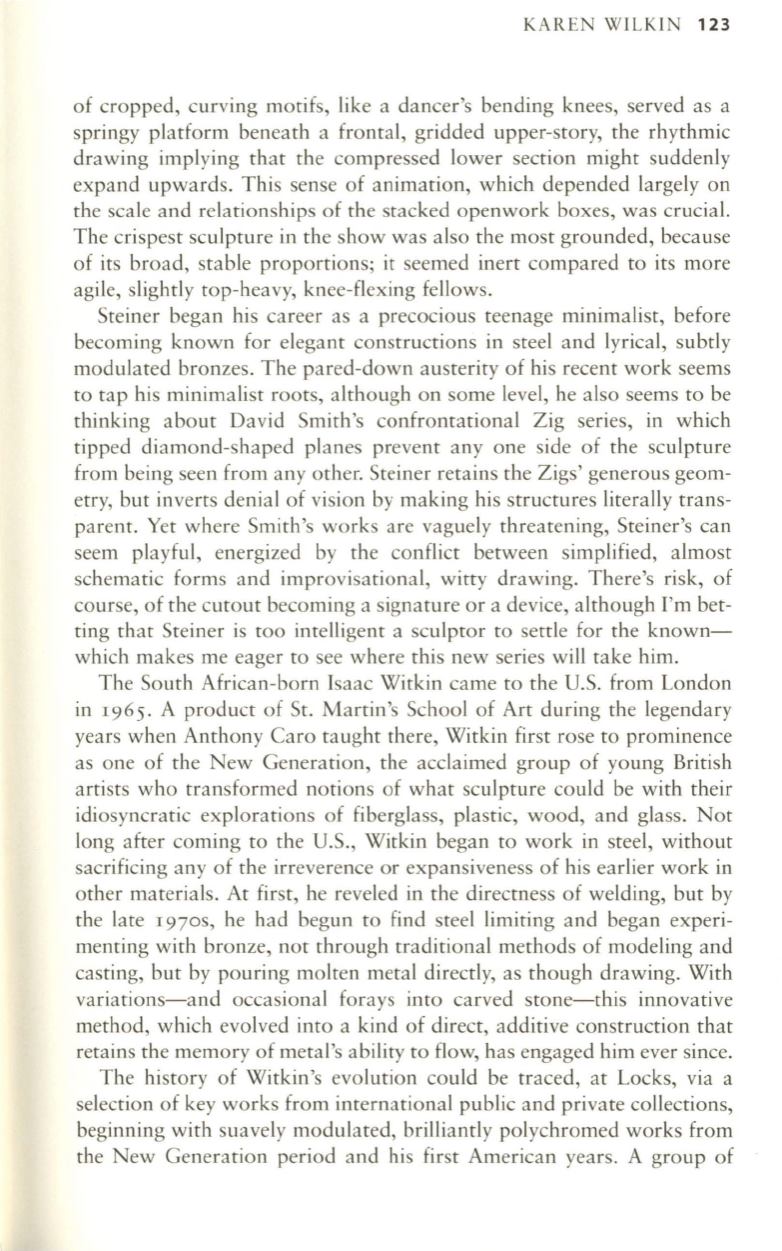
KAREN WILKIN
123
of cropped, curving motifs, like a dancer's bending knees, served as a
springy platform beneath a frontal, gridded upper-story, the rhythmic
drawing implying that the compressed lower section might suddenly
expand upwards. This sense of animation, which depended largely on
the scale and relationships of the stacked openwork boxes, was crucial.
The crispest sculpture in the show was a lso the most grounded, because
of its broad, stable proportions; it seemed inert compared to its more
agile, slightly top-heavy, knee-flexing fellows .
Steiner began his career as a precocious teenage minimalist, before
becoming known for elegant constructions in steel and lyrical, subtly
modulated bronzes. The pared-down austerity of his recent work seems
to tap his minimalist roots, although on some level, he also seems to be
thinking about David Smith's confrontational Zig series, in which
tipped diamond-shaped planes prevent anyone side of the sculpture
from being seen from any other. Steiner retains the Zigs' generous geom–
etry, but inverts denial of vision by making his structures literally trans–
parent. Yet where Smith's works are vaguely threatening, Steiner's can
seem playful, energized by the conflict between simplified, almost
schematic forms and improvisational, witty drawing. There's risk, of
course, of the cutout becoming a signature or a device, although I'm bet–
ting that Steiner is too intelligent a sculptor to settle for the known–
which makes me eager to see where this new series will take him.
The South African-born Isaac Witkin came to the U.S. from London
in 1965. A product of St. Martin's School of Art during the legendary
years when Anthony Caro taught there, Witkin first rose to prominence
as one of the New Generation, the acclaimed group of young British
artists who transformed notions of what sculpture could be with their
idiosyncratic explorations of fiberglass, plastic, wood, and glass. Not
long after coming to the U.S., Witkin began to work in steel, without
sacrificing any of the irreverence or expansiveness of his earlier work in
other materials. At first, he reveled in the directness of welding, but by
the late 1970s, he had begun to find steel limiting and began experi–
menting with bronze, not through traditional methods of modeling and
casting, but by pouring molten metal directly, as though drawing. With
variations-and occasional forays into carved stone-this innovative
method, which evolved into a kind of direct, additive construction that
retains the memory of metal's ability to flow, has engaged him ever since.
The history of Witkin's evolution could be traced, at Locks, via a
selection of key works from international public and private collections,
beginning with suavely modulated, brilliantly polychromed works from
the New Generation period and his first American years. A group of


